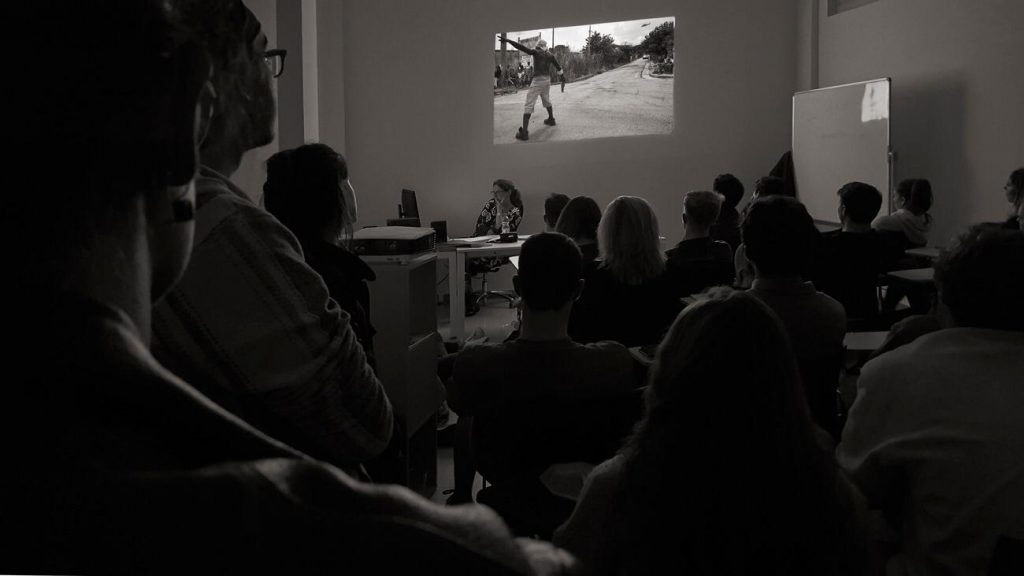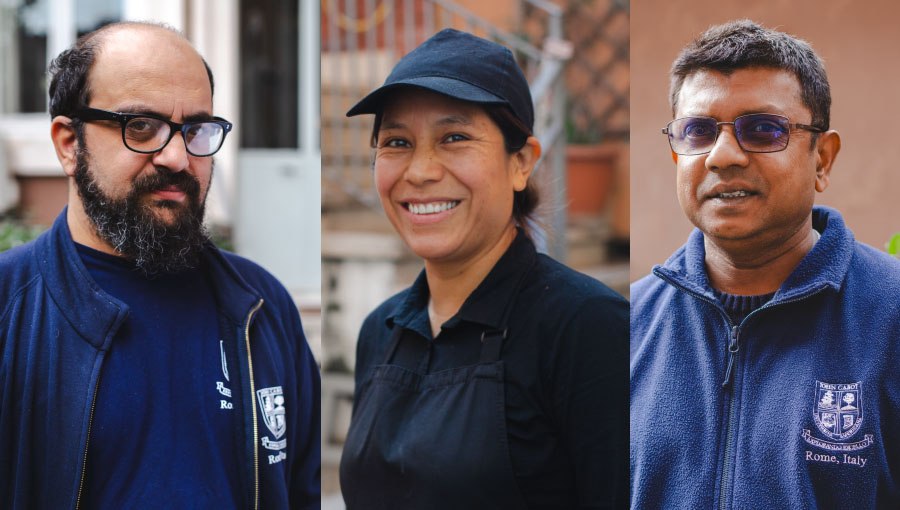Organized Crime and Life: JCU Welcomes Photographer Giovanni Izzo
John Cabot University welcomed photographer Giovanni Izzo for a screening of his project The Domitiana: Everyday organized crime and life on November 6, 2018. The event was sponsored by the Departments of Modern Languages and Literature and Art History.
More than just a photography exhibition, The Domitiana is a 15-minute-long projection of black and white images that document the everyday life of migrants and other residents in and around Castelvolturno, about 50 kilometers from Naples. The title refers to the road in the Campania region that currently hosts about 25,000 undocumented migrants who are the main subjects of Izzo’s project. The pictures, chosen from the 500,000 that Izzo took over the course of fifteen years, chronicle organized crime, exploitation, and institutional neglect in the area, revealing a disturbing side of contemporary Italy that is usually hidden from the public eye.
“Depressing yet beautiful, the photos turn horror into art,” according to Italian Studies professor Isabella Clough Marinaro. The main themes of the exhibition are prostitution, drugs, the Nigerian mafia, forced labor, and pollution. Some pictures are strikingly crude, like that of a prostitute leaning on a wall with a vendesi, (“for sale”) sign daubed on it. Or that of a Nigerian woman with a heavily powdered face, in an attempt to please clients who expect women to look like Barbies, as Izzo explained. Other photographs show the inside of a house with the words “one love” and “thug life” juxtaposed on the wall; a man with a gun to his head; a man playing the violin inside the ruins of a building.
When asked about the ethical aspects of his work, Izzo said that it is complicated. He explained that when you work in criminal environments, you are sometimes forced to photograph surreptitiously, otherwise “non fai più niente,” you will not get anything done. According to Izzo, there is often no other way to report situations and breaking the rules becomes a necessity. He also declared that some of the pictures he has taken over the years simply cannot be shown, because of their delicate subject matter.
An essential aspect of Izzo’s job is to get people to trust him. Over the years, he has gained the trust of both criminals and victims, who vouch for him when he goes to places where he normally would not be admitted. He said that it can take up to 3 years to take a photograph, and he revealed the great lengths that he has gone to in order to gain some people’s trust, such as sitting in the back row of a church on Sundays for two years before starting to take photos. Despite this, Izzo has received numerous threats.
Izzo’s perseverance has allowed him to document aspects of drug trafficking as well. One picture shows drug packets wrapped in two different ways to demonstrate how the technique has changed over the years. According to Izzo, doctors in Nigeria discovered that drug packets wrapped in carbon paper are not picked up by x-rays and that traffickers use this method to smuggle money as well. Izzo explained how up to 10,000 euros in bills of 500 can be folded numerous times, wrapped in carbon paper, and swallowed.
 Izzo said that his job is dangerous and that at times he finds himself in unsafe situations, but that “if you don’t take risks, you won’t get results.” He said that sometimes he informs the police about where he is going, but not always. He told the story of how he took one photograph of men and women belonging to the Nigerian mafia, including the heads of the organization in Castelvolturno and Rome, and the main “madame” sitting at a table. According to Izzo, these meetings happen 2 or 3 times a year and are masked as big parties hosting up to 500 people, so that the heads of the Nigerian mafia are harder to identify and can discuss business without the risk of being heard. Izzo was the only Italian present and he managed to get in thanks to his friendship with a Nigerian invitee. But when the guests started noticing that Izzo was going around taking pictures, someone grabbed him by the neck and threw him out. Izzo said that he hadn’t told anybody where he was, and that at that moment he was truly scared that things could turn out very badly for him.
Izzo said that his job is dangerous and that at times he finds himself in unsafe situations, but that “if you don’t take risks, you won’t get results.” He said that sometimes he informs the police about where he is going, but not always. He told the story of how he took one photograph of men and women belonging to the Nigerian mafia, including the heads of the organization in Castelvolturno and Rome, and the main “madame” sitting at a table. According to Izzo, these meetings happen 2 or 3 times a year and are masked as big parties hosting up to 500 people, so that the heads of the Nigerian mafia are harder to identify and can discuss business without the risk of being heard. Izzo was the only Italian present and he managed to get in thanks to his friendship with a Nigerian invitee. But when the guests started noticing that Izzo was going around taking pictures, someone grabbed him by the neck and threw him out. Izzo said that he hadn’t told anybody where he was, and that at that moment he was truly scared that things could turn out very badly for him.
A photographer for almost forty years, Giovanni Izzo has won awards and published various books. He was the on-set photographer for the film Il Vizio Della Speranza by Edoardo De Angelis. The Domitiana: everyday organized crime and life has traveled internationally and has received glowing reviews by Newsweek, the BBC, and many other English and Italian publications. It will soon be screened at the European Parliament in Brussels.






